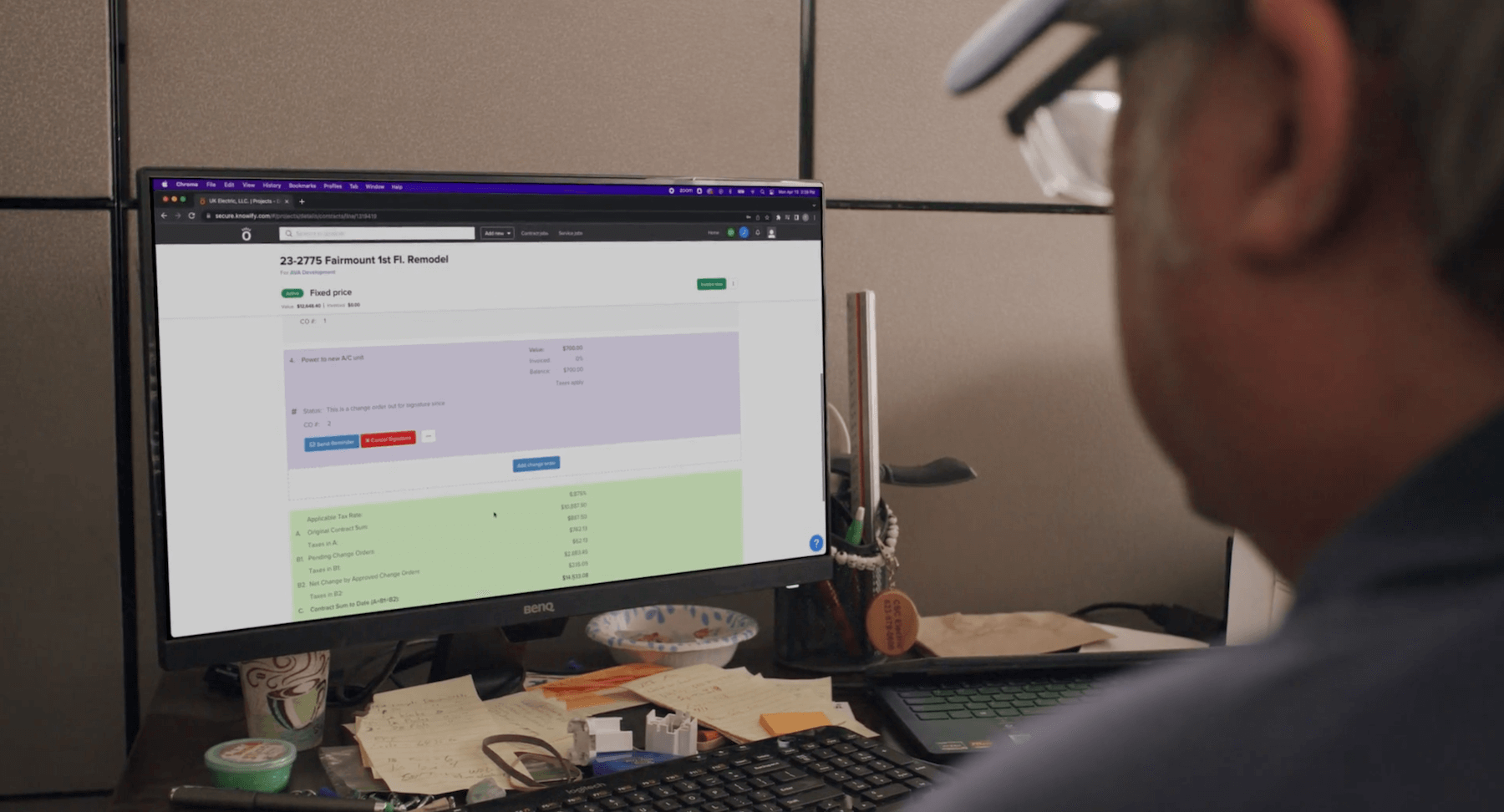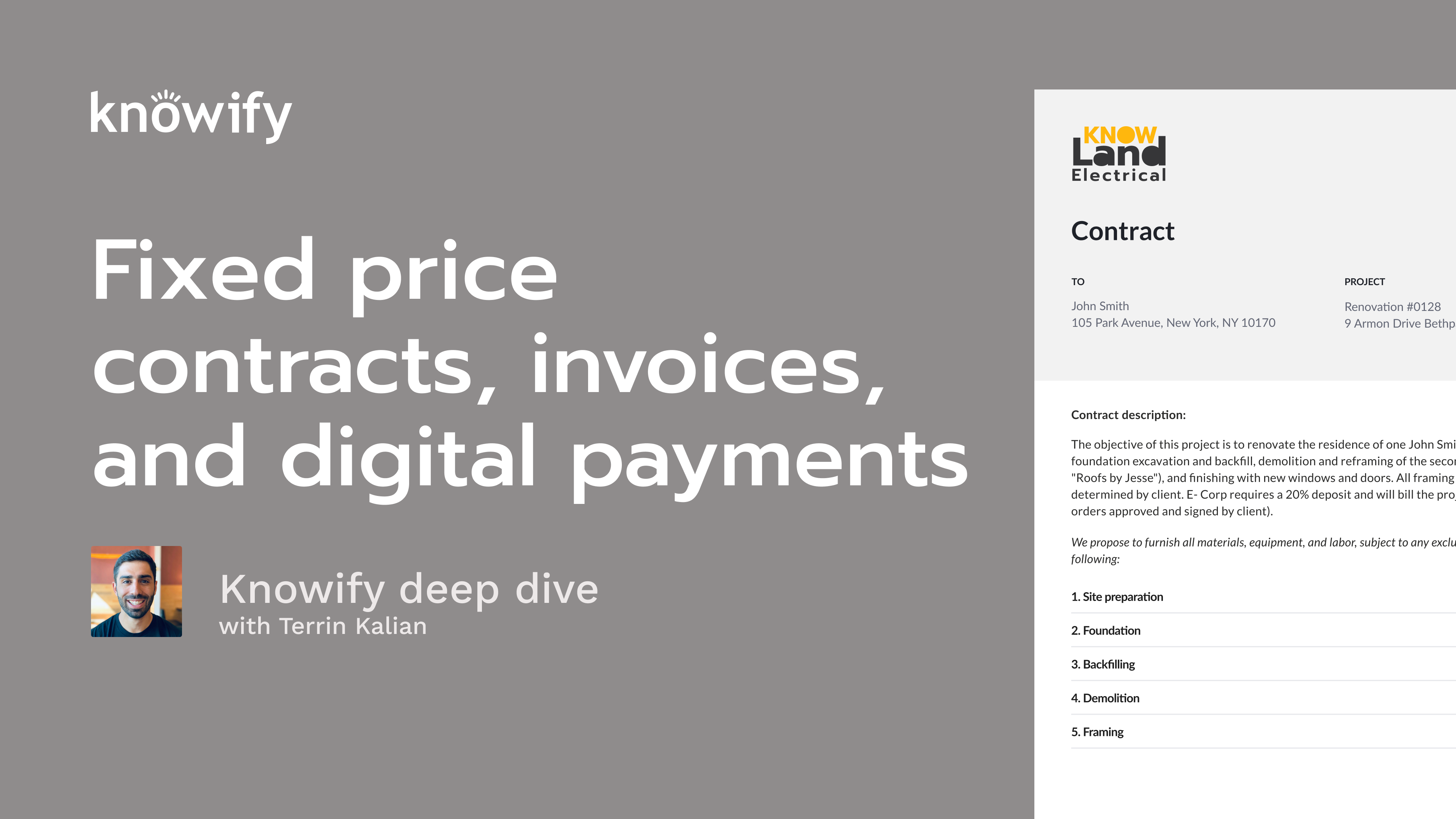There is a concept in the contracting world known as kicking the can down the road. This looks something like going in too low on a bid or taking a job that doesn’t have great terms or margins simply because you need the work so you can ensure you have cash coming in. This can also come in the form of cash-flowing your next job with the cash from the previous job. This is the classic dilemma of construction cash flow management.
Although this is common in the construction industry and may work great for some contractors, for others, you’ll just be putting off tough decisions for another day. Because of this, managing cash flow is a deceptively complex aspect of running a contracting business. It’s not as simple as money in vs. money out.
But managing your cash flow shouldn’t feel impossible. And with the right know-how and strategies, contractors can turn managing their cash flow from overwhelming to profitable.
Uses of cash in construction
Contractors’ primary source of cash comes from the revenue they earn from performing work and completing jobs. Cash is this used to pay for labor, materials, equipment, and hitting payroll, as well as to cover any other expenses related to running a business.
Additionally, contractors will need cash for day-to-day operations. Each job (and likely each job phase) will have its own unique set of cash requirements. This means it’s crucial to budget and plan for how much cash is needed each week to complete a job on schedule.
A non-exhaustive list of cash needs for construction companies
☐ Paying for transport of goods
☐ Paying for labor and wages
☐ Obtaining short-term financing
☐ Meeting tax obligations
☐ Buying machinery and equipment
☐ Making insurance premiums payments
☐ Financing routine maintenance expenses
☐ Making investments in new markets
☐ Covering unexpected costs and emergency expenses
☐ Building up cash reserves for future use
What problems can be solved through better cash flow management?
Uncovering business needs
Cash flow management uncovers crucial financial information that is often overlooked. When projects are in full swing and deadlines are approaching, it can be all too easy to let cost tracking fall to the wayside.
Maintaining a close eye on cash flow will help contractors keep a pulse on overall financial health by revealing where you consistently overspend, where you lack efficiency, and when you aren’t working enough jobs in the present to fund upcoming projects.
Reviewing that data will uncover eye-opening insights into your business, a big one being where you consistently overspend, and with this information, you will have the business intelligence needed to keep your business alive and healthy.
How to strategically use cash
Another problem solved is how and when to use the cash that is coming in. For example, let’s say a job is won and the contract pays $100,000, and you’ll make 20% on that job. This means you can expect $20,000 to come in over the course of that job.
However, if you continue on that assumption, it can put you in a tricky situation. If the amount or timing of payments changes (which is likely) or expenses start to increase, you may find yourself spending more than you are invoicing.
It’s essential to know this is happening. It means you can’t use any of the cash from this job for anything else. Don’t buy new tires for the company vehicle, and don’t buy a new ladder for the next job. The only acceptable use of this cash in this situation is to reinvest it back into the current job.
A core principle of cash flow management is understanding that just because you have cash coming in doesn’t mean you’re free to use that cash however you want. It’s advised that you use cash in a more strategic way to ensure you have the resources you need to keep jobs moving forward and on schedule.
With that said, managing cash flow carefully will help mitigate these issues. Cash flow management comes down to knowing exactly how much cash you’ll need throughout a project so that you can make the right decisions. If you can better anticipate where you’ll have cash flow issues and create a plan, you can put yourself in a better position to succeed.
6 cash flow management tips for construction contractors
1) Plan and forecast cash flow
When it comes to cash flow management, plan for the worst and prepare for surprises. Through careful planning and forward-thinking, you can make long-lasting improvements to your cash flow, ensuring your jobs are properly financed.
This starts with looking inward toward your current financial standing. For instance, you probably don’t want to go out and buy a new piece of equipment just because your bank account currently looks flush with cash.
Start by understanding the billing position of your jobs vs. cost to complete. For example, are you overbilled–meaning you’ve billed for more than the work you’ve actually completed? Conversely, you’re underbilled if you’ve completed work that you haven’t billed yet.
Before you take on a job, spend some time scenario planning; try to anticipate any situations for the upcoming job that you know will impact cash flow. Then think of some steps you can realistically take to mitigate those circumstances. For example, what happens if your customers slow down on payments? If your largest customer is late a month on an invoice, what kind of impact will this have on your cash position?
Another scenario to budget for is any large cash flow drawdowns, such as making a down payment to a vendor ahead of receiving cash from your client. Although you should try to avoid this (more on this later), you may need to pay upfront to secure materials or supplies to keep a project on schedule. It’s crucial that you ensure you have enough cash available to cover these fronted costs.
By properly budgeting and planning for cash-flow drawdowns, you can better manage your finances, reduce the risk of unexpected costs, and ensure that projects remain on budget and schedule.
2) Strategically negotiate deposits and invoicing milestones
To ensure you’re not bearing the burden of any large cash hits early in a project, it’s crucial to negotiate favorable terms around your deposits and invoicing milestones. To do this, ask yourself: are there going to be any big cash drains early in the project (like a big concrete pour)?
If so, try to collect a deposit from your client at the beginning of the job. If they don’t agree to that, you can try to structure payment terms so that you’ll receive payment from your client before you have to pay any vendors; you can read more about that below in item #3.
For large jobs, you should try to ensure that the amounts paid at each milestone cover the cash requirements for the next phase of the job. This way, you don’t have to go looking for cash from elsewhere (reserves, bank loans, etc.) to cover the cash outflows required to perform the upcoming work.
Utilizing these methods (i.e., collecting upfront deposits and payment at each invoice milestone) will ensure that you’re not incurring any project-breaking financial burdens.
3) Improve your Accounts Receivables practices
a) Get customers to pay quickly
Inevitably, some customers will be slow to pay–any contractors working on government contracts will be sure to attest to this. However, it’s vital that you do everything you can to secure quick and timely payments from your customers. As a subcontractor, you have more sway here than you might realize.
Start by negotiating reasonable payment terms in your contracts. Anything beyond Net30 should be seen as unfavorable to you and likely unreasonable. Try to negotiate for Net30 or lower (e.g., Net15). Net30 or lower payment terms offer considerable benefits to contractors, mostly through the improved stability of cash flow. It will increase your chances of getting paid by placing shorter time constraints on payments.
The less time there is to pay, the more inclined clients are to issue prompt payments to avoid halting projects or late fees (more on this later). In addition, Net30 or below will make it much easier for you to match your cash outflows (payroll, vendor bills) with cash inflows.
To further increase your chances of prompt payments, negotiate interest rates for late invoices. This will apply a late fee to overdue payments, expressed as a percentage (e.g., 1.5% per month). Don’t feel like you always need to take advantage of this, especially if your customer is only a few days late.
With that said, however, interest rates on late payments can do a lot to protect you from clients that fall behind by several months. It’s a pragmatic solution to further compel project owners to make timely payments. After all, you’ll need to front costs or borrow money to make up for their late payments.
b) Pay attention to invoicing cycles
Be sure to understand if your contract specifies an invoicing cycle–i.e., a certain day by which invoices much be received. If it does, never miss a cycle! Submitting an invoice late, even by a day or two, is an unforgivable mistake.
If you’re a subcontractor working with a large general contractor, expect them to reject such a late invoice. If this happens, your cash position will be seriously hit for the next 30 days!
c) Be careful with retainage
General contractors and project owners are notorious for dragging out retainage payments. For this reason, try to negotiate a variable or “burn down” retainage rate that would bring retainage from 10% to 5% (releasing 50% of retained funds to date) after a job hits substantial completion, which is typically around 80-90% complete.
If something isn’t made clear regarding your retainage terms, don’t wait to bring up these questions. It’s crucial to address any issues you have upfront. Iron out payment timelines and unique details like earning interest. If you know retainage terms will cause cash flow issues, bring it up to your GC or owner.
4) Improve your Accounts Payable practices
See to it that your payment terms with vendors aren’t worse than your own payment terms with your clients. If you’re due on receipt with your vendors and Net30 terms with your customers, there’s cash waiting to be recaptured with an adjustment of your payment terms. Alternatively, many vendors will be willing to offer discounts for fast payment. Over the course of a year, these discounts can add up to quite a bit of real savings.
5) Have backup plans in place for cash-crunches
Not having an emergency fund is an emergency of its own. Take immediate action to make it a habit to save funds into a reasonably-sized contingency fund. This emergency fund will be a true lifesaver when you find yourself strapped for cash in the middle of a job. It’s a vital form of risk management that you shouldn’t overlook. Every contractor needs one. It’ll allow you to cover unexpected costs during the course of a project that would otherwise come out of pocket.
Having an established contingency fund will serve as an internal insurance policy. For this reason, this is the best approach for mitigating cash flow challenges, as it’s using your money on your terms. There is no bank, lender, or third party involved.
Wanting to stay away from debt is perfectly understandable. However, financing isn’t always a bad thing, especially if it’s done responsibly and with caution. If you choose to go this route, look into services that offer receivable factoring or collateralized lending. These types of loans will allow you to address any immediate cash needs without selling off assets. Additionally, if you’re working with well-known counterparties, these types of financing providers will be very likely to work with you.
-
- Collateralized lending: This is a type of financing that uses an asset as collateral to secure a loan. In other words, you’ll use an asset (land you own or construction equipment) as an assurance that you’ll pay back the loan.
-
- Credit facility: Another option is to seek a credit facility for your business. A credit facility will allow your business to take out money over an extended period of time rather than several loan applications made each time you need capital. This provides a fast and flexible way to source cash when you need it most. Through the use of credit facilities, a lender and borrower can gain greater flexibility in lieu of the traditional loan models. Just keep in mind that your financial situation and credit history will determine the terms and conditions provided by the credit facility.
6) Be more profitable
Like the great John Madden once said–“you can’t win a game if you don’t score any points.” While laughably obvious, the same applies to your business. If you’re not consistently generating a healthy profit, then your cash flow woes are sure to continue. In truth, the biggest driver of healthy long-term cash flow is profitability.
Ask yourself the following questions:
-
- Do you have the job costing tools in place to maximize profitability across your business?
-
- Do you know which kinds of jobs make you more money and which make you less?
-
- Have you identified potential growth in your business based on market demand and your company’s expertise and competitive position?
Job costing consistently will build a historical data set for contractors to understand the profitability of each and every job. This data lets you know where and how you are making money on each job. Tracking costs in this way will let you know what types of jobs are the most or least profitable. With this information, you can avoid taking jobs that are likely to be unprofitable. If the numbers show that a job won’t be profitable, think twice about taking that job.
This is an easier mistake to make than most contractors think, especially if they aren’t consistently job costing and reviewing that cost data. It’s nearly inevitable that you’ll spend more than you make if you don’t have access to or aren’t paying attention to cost data.
For many jobs, your income is your budget, and you simply can’t spend more than you’re bringing in. Reviewing job costing data from previous jobs will give you vital information to better plan and budget for future jobs.
Final thoughts
At the end of the day, don’t feel discouraged that you haven’t mastered everything there is to know regarding business finance. Focus on the big picture items first. Understanding the ebb and flow of cash flow is a giant step forward in terms of taking more control of your finances.
Understand that you don’t have to go at this alone. Lean on trained financial professionals equipped to handle the tough and nuanced financial side of the construction business.
If you have the means, hire a CPA that can help you avoid common mistakes and guide your business to a better financial standing. Whether hiring internally or through a third party, try to find an accountant that is a good fit for your specific business that understands your trade and industry.
Finally, utilize software built specifically for you. Knowify is construction accounting and project management software built for contractors in the specialty trades. Improve project costing, project management, invoicing, and more with our paperless and powerful tools that allow you to build your business with confidence.
To get started, schedule a free 30-minute demo with one of our experts today!
 QuickBooks
PricingTraining & support
QuickBooks
PricingTraining & support



